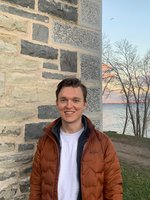Bio: Colin Vendromin, CQIQC PDF with an appointment at the Physics Department, works with Professor John Sipe and has interests in theoretical quantum optics.
Colin earned his B.Sc. and M.Sc. in physics from Brock University in St. Catharines, Ontario in 2014 and 2017. He then completed his Ph. D. studies at Queens’ University in Kingston, Ontario in 2022 under the supervision of Marc Dignam.
CQIQC: Tell us about what's involved in your particular area of expertise.
CV: I work in an area of physics called quantum optics. Specifically, I work with the theory of how particles of light called photons interact with matter. When a laser is shone onto a specific crystal, an interaction can take place between the photons in the laser and the atoms in the crystal. This results in the splitting of laser photons into pairs of new photons, called (for historical reasons) the signal photons and the idler photons. The resulting signal and idler photons have properties, like frequency and polarization, that are correlated with each other regardless of their spatial separation. This entanglement shared between the photons of light has applications to quantum computing, secure key distribution, and quantum communication.
CQIQC: What led you to be interested in this particular area, and how did it bring you to U of T?
CV: I like working on theoretical problems in physics that have practical applications.
I originally became interested in physics because of quantum mechanics, and this lead me to study quantum optics in my Ph. D. I chose to come to U of T for physics because the department has a good theoretical quantum optics group with many opportunities to collaborate with other groups from around the world.
CQIQC: What are you currently working on?
CV: Currently I am working on the generation of entangled photon pairs on photonic integrated devices. My work is entirely theoretical but it has applications to quantum key distribution and quantum computing. Also we collaborate with a few experimental people who are building real devices to test these theories.
CQIQC: What would you say has been your career highlight to date?
CV: Pinpointing a specific career highlight is challenging, as my time in quantum optics has been short so far. I am just happy to work on intriguing physics problems and contribute to the understanding of quantum optics. The theoretical exploration is often rewarding enough.
CQIQC: Do any challenges loom especially large for researchers in your area?
CV: An obvious challenge for some researchers in quantum optics and its related fields is to build and scale-up a quantum computer that uses entangled photons as a resource.
CQIQC: If you met someone considering the U of T post doc program, what advice might you give?
CV: I would recommend searching for a postdoc program that offers the opportunity to collaborate with many other experimental and theoretical researchers, in order to increase your research capacity. Also, spend time practicing supervising students in the research group. Learn and improve skills like programming that will help you in academia but also then transfer to industry jobs.
And--something that is hard for me, but I think is common advice to hear--is make sure you network with people in your field and related fields.
CQIQC: Where do you think your research will take you next?
CV: I think my work will ultimately contribute to a deeper understanding of the types of light that can be generated on a chip. This work has practical implications for applications in quantum key distribution and quantum computing. Additionally, I anticipate that my research could help the practical development of different kinds of on-chip structures designed to enhance the generation of specific types of light. This mix of theory and practical applications will help to advance the capabilities of photonic integrated devices, opening up new possibilities in the realm of quantum optics and emerging technologies.

